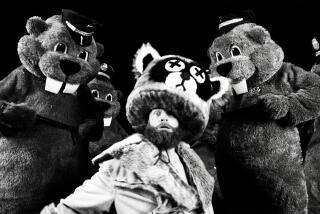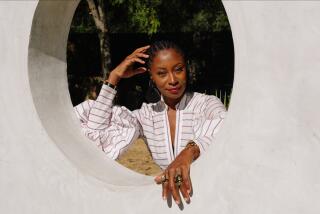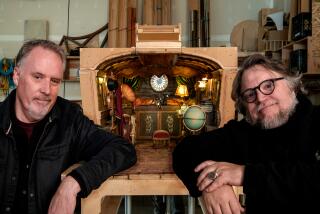How the academy is celebrating eccentric dance from ‘Wizard of Oz’ to ‘Aladdin’
It was wacky and wild, dazzling to watch, funny and fearless. It couldn’t be called modern dance and it certainly wasn’t ballet. The only word for it was “eccentric.”
Eccentric dance can trace its origins to ancient times and has roots in many cultures. But perhaps no place did it flourish more than in the movies, particularly from the 1930s to the 1950s.
Think of rubber-legged Ray Bolger in 1939’s “The Wizard of Oz” and 1952’s “Where’s Charley?”; long-limbed Charlotte Greenwood, whose trademark high kicks entertained audiences in such musicals as 1940’s “Young People” and 1955’s “Oklahoma!”; and the gravity-defying Nicholas Brothers — Fayard and Harold — whose leaps and astonishing splits were the high points of numerous musicals including 1940’s “Down Argentine Way” and 1941’s “Sun Valley Serenade.”
On Monday at the Samuel Goldwyn Theater, the Academy of Motion Picture Arts and Sciences is shining a spotlight on eccentric dancing and how the art form has also played an important role in animation.
“The Choreography of Comedy: The Art of Eccentric Dance” will feature film clips of some of the greatest eccentric dancers, including home movies of the Nicholas Brothers introduced by Fayard’s son Tony; a 1911 clip of Fred Stone, who played the Scarecrow in the 1903 silent version of “The Wizard of Oz”; a panel discussion including actor-director-writer Simon Callow, animator and dance historian Betsy Baytos and animator Eric Goldberg (“The Princess and the Frog,” “Aladdin”); and several performances, including a special tap dance from choreographer DeWitt Fleming Jr.
“What eccentric dance is, by definition, is very broad,” said Baytos, the curator and host of the evening, who is also an animator and eccentric dancer and choreographer. “It’s loose-limbed. It’s a pantomimic kind of movement, and it’s usually comic by nature. It’s essentially wrapped around the character.”
Tony Nicholas, the son of Fayard, is excited to show Nicholas Brothers home movies Monday evening because they are “something to behold.” He’ll be screening some “exciting new footage we have discovered that no one has ever seen.”
His father and uncle, said Nicholas, never had a dance lesson. “They taught themselves how to dance, and really,” he explained, “it was my father who taught himself how to dance and basically taught his younger brother. They did their own choreography. The director and the choreographer of a film would just say, ‘Listen, have you thought about doing something with this music and what do you think about it?’ So, my father would say, ‘I’ll tell you what I think about it; we’re going to do it.’ My father put together the choreography for all of those great routines. There were always choreographers there, but all they could do was suggest. They certainly couldn’t do the steps.”
Baytos noted that the first Disney film she worked on as an animator was 1977’s “The Rescuers.” “Being that type of dancer, I was constantly getting up and acting out the characters and the character movements,” she said. The first feature she choreographed was the animated dragon Elliot in 1977’s “Pete’s Dragon.” “I put a tail on my rear end and went out in the parking lot and they filmed me,” she laughingly recalled.
Animator Goldberg talked about the link between the seemingly impossible movements of eccentric dancers and animation.
“We’re trying to convince you that there’re certain things our characters can do that you find illogical but look completely believable. You have to animate a character with a certain amount of weight and intent and all the things that actually make it completely believable for an audience.”
Goldberg and Fleming will be involved in a unique animation and dance presentation Monday evening. The animator will be drawing Mickey Mouse live, which will segue into the 1936 Technicolor cartoon “Thru the Mirror.”
“It starts with Mickey Mouse having fallen asleep reading ‘Alice Through the Looking-Glass,’” Goldberg said. “His dream image comes up while he’s sleeping and walks through the mirror and everything is nuts on the other side. He does this kind of tap dance with a matchstick that’s just beautiful animation.”
Enter Fleming, who will be re-creating the dance. “That’s a short clip,” Fleming said. “So, you’ll see him doing it and then you see me doing it right below. After that kind of fades out, then I’ll continue with the band and do more of a solo tap dance number.”
'The Choreography of Comedy: The Art of Eccentric Dance'
Where: Samuel Goldwyn Theater, 8949 Wilshire Blvd., Beverly Hills
When: 7:30 p.m. Monday
Tickets: $3-$5
Info: oscars.org
More to Read
Only good movies
Get the Indie Focus newsletter, Mark Olsen's weekly guide to the world of cinema.
You may occasionally receive promotional content from the Los Angeles Times.






